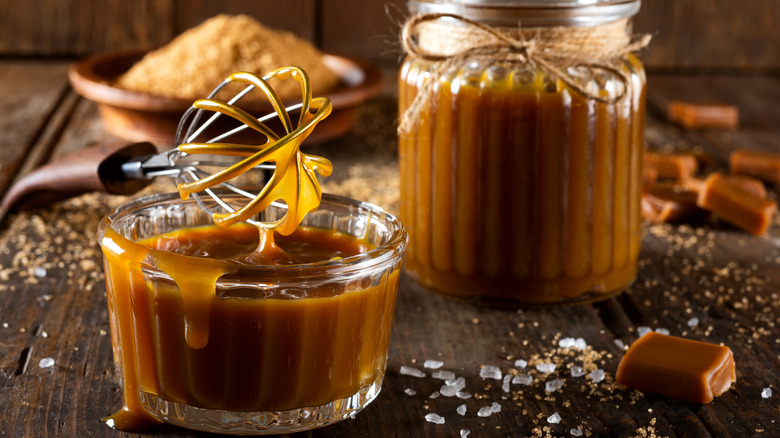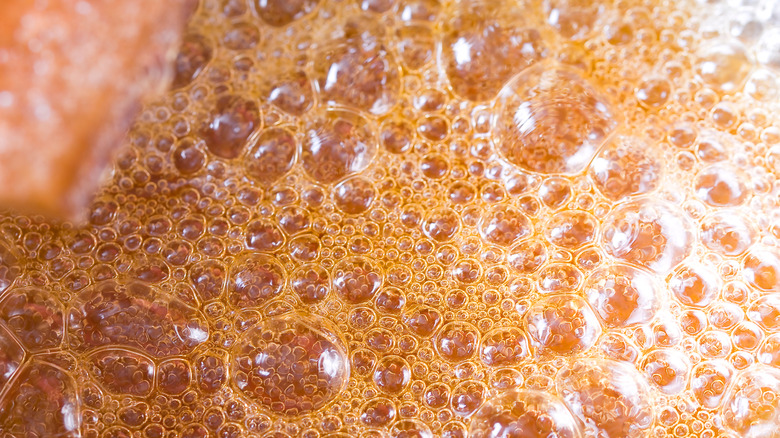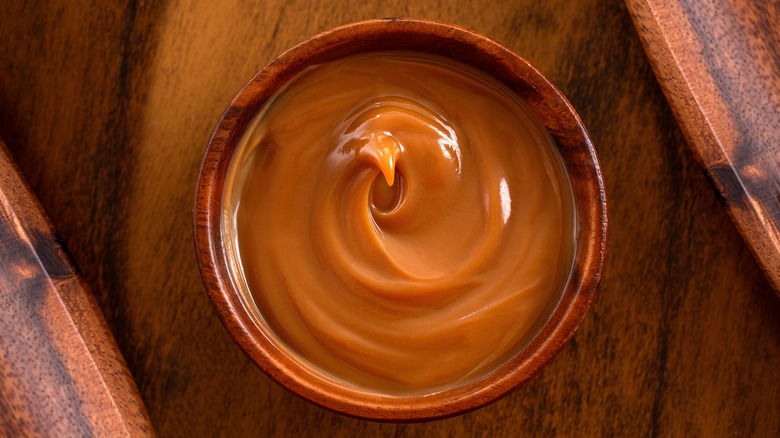The Major Difference Between Caramel Sauce And Dulce De Leche
We may receive a commission on purchases made from links.
It's mind-blowing how simple white granulated sugar can be transformed into a complex confection like caramel sauce or dulce de leche. Sweet, luxurious, and decadent, both dulce de leche and caramel can be made at home with varying degrees of difficulty. Although modern caramel is often attributed to the French, an early variation of caramel is thought to have originated over 1,000 years ago in the Middle East. Dulce de leche is believed to have roots in Indonesia and the Phillipines before being adopted by the Spanish and then brought to Latin America via trade routes and colonization in the 1500s.
The biggest difference between caramel sauce and dulce de leche lies in the core ingredients. Caramel is merely sugar (or sugar and water), while dulce de leche is made with sugar and milk. While a true caramel is made with just sugar and sometimes water, there can be some confusion as soft caramel candies and caramel sauces are often made with the addition of heavy cream, butter, or corn syrup. Caramel sauces and confections often have other flavoring added to them, including savory twists with fish sauce or hearty herbs like rosemary or sage. Vanilla is one of the most popular flavors added to caramel along with flaky salt. Dulce de leche can be made from scratch but is commonly made at home with one ingredient and a simple shortcut.
Caramel is little more than sugar and heat
Caramel can be a finicky beast to make at home, as working with hot sugar is a precise and sometimes dangerous process, and burns caused by molten sugar are especially painful. Sugar and water are slowly heated on the stovetop to between 320-340 degrees Fahrenheit, depending on the desired color and flavor. Caramel can be made with a wet or dry method: Wet caramel includes water to aid in the dissolution of the sugar granules before heating, while dry caramel is nothing more than slowly heated granulated sugar.
Caramel is the beautiful, golden brown base layer of flan and crème caramel and is perfect to drizzle over vanilla ice cream or turn into candies like almond brittle. If you plan on embarking on a caramel journey at home, be sure to review these mistakes to avoid when making caramel first, since crystallization of the sugar granules is a very common occurrence that's difficult to correct once it starts and will ruin your desired silky caramel.
Thankfully, we have the tips you need to make the perfect caramel sauce. There's nothing wrong with store-bought caramel, however, and there are plenty of stellar caramel sauces available for purchase, like Torani puremade caramel sauce. With delicious uses for canned caramel sauce, like adding it to your afternoon coffee for a luxurious latte, there's no need to struggle with making caramel at home if you're not interested.
Dulce de leche transforms milk and sugar into a mouth-watering spread
Dulce de leche roughly translates to "candy of milk" or "sweetness of milk." It is made with sugar and milk, so it has a more rich, creamy texture than caramel due to the addition of dairy and removal of water. The depth of flavor achieved in dulce de leche is thanks to our old friend the Maillard reaction, which occurs when sugar and protein heat up. Since a true caramel does not contain dairy, it lacks the protein element to have it's flavors transformed by the Maillard reaction, making the flavor of dulce de leche that much more complex than a simple caramel.
If you're pressed for time or simply looking for a shortcut, dulce de leche is very commonly made by boiling a can of sweetened condensed milk to make a "cheater" version that's still wonderfully delicious. Dulce de leche is not to be confused with cajeta, which is a Mexican version made with goat's milk that may look similar but has a slightly different flavor profile. Dulce de leche is usually a much thicker consistency than caramel, which makes it great for layering or stuffing, like these dulce de leche-stuffed millionaire's shortbread cupcakes, or incorporating into a frosting like Swiss meringue buttercream. And you may have had dulce de leche in a popular South American dessert known as alfajores, which features dulce de leche sandwiched between two shortbread cookies.


